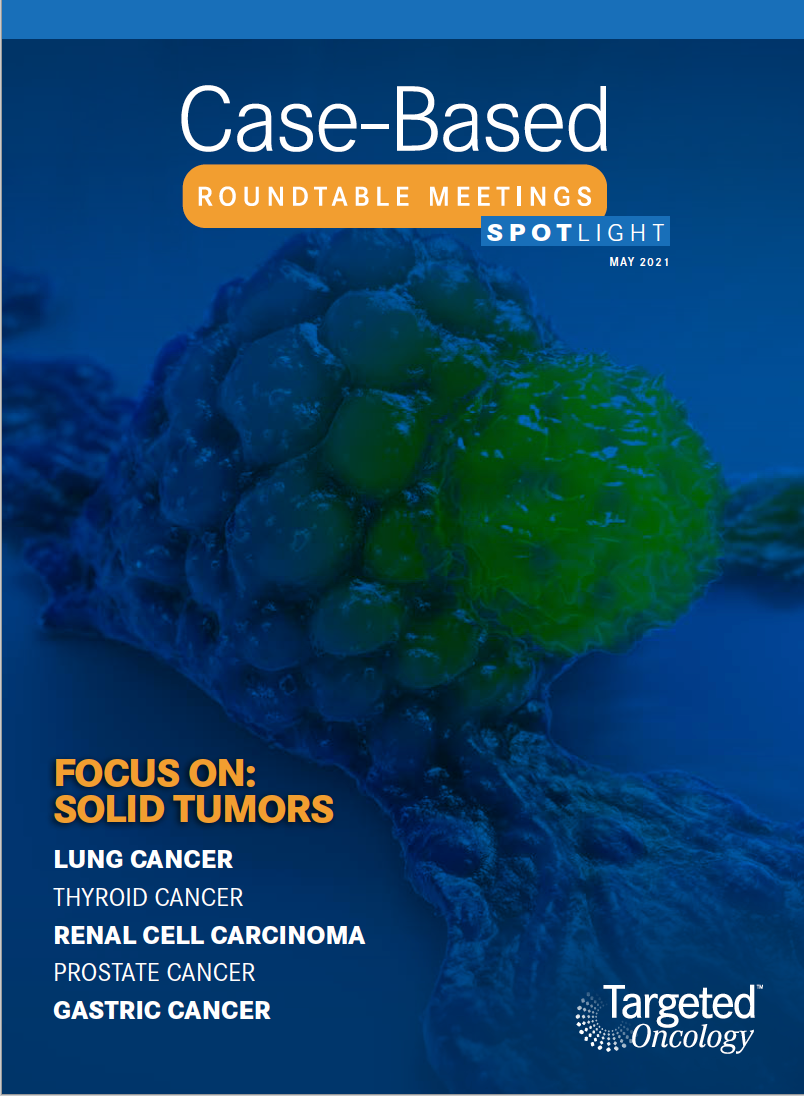Trials in NSCLC Yield Varying Results for Levels of PD-L1 Expression
During a virtual Targeted Oncology Case-Based Roundtable event, Timothy F. Burns, MD, PHD, discussed the treatment of non–small cell lung cancer based on clinical trial research.
Timothy F. Burns, MD, PHD

During a virtual Targeted Oncology Case-Based Roundtable event, Timothy F. Burns, MD, PHD, assistant professor of Medicine in the Division of Hematology-Oncology, and associate program director for Research in the Hematology/Oncology Fellowship Program at UPMC Hillman Cancer Center, discussed the treatment of non–small cell lung cancer based on clinical trial research.
MOLECULAR TESTING
With the use of FDA-approved first-line therapies, the National Comprehensive Cancer Network (NCCN) guideline recommends the use of a next-generation sequencing panel, either blood-based or tissue-based.1 When performing these tests, for patients with non-small cell lung cancer (NSCLC), it is best to avoid sending samples out to commercial labs that perform 1 test at a time, as this uses up too much of the available tissue.
Plasma-based testing is an effective approach, but it is important to know how to interpret the results. The testing is less useful for gene-fusion analysis. The absence of a driver mutation upon blood-based testing does not necessarily mean that the tumor is negative for ALK, ROS1, NTRK, or RET because the sensitivity, depending on the test, ranges from about 30% to 40%. Accordingly, the majority of gene fusions will be missed. If a blood-based test does detect a gene fusion, physicians can trust this result and treat based on that, said Timothy F. Burns, MD, PhD. If a gene fusion is not detected, then further testing is warranted. If a driver mutation, such as EGFR, BRAF, MET or a KRAS, is detected, physicians can treat based on that. However, if the test detects only a TP53 or BRCA1 mutation and no gene fusion, then they have to assume that this is an uninformative test.
PATIENT SUBSETS
The population of patients with lung cancer can be divided into subsets of those with oncogenic drivers, which have FDA-approved drugs that are intended for use in the first-line setting where they are most effective. In general, this group does not respond as well to immunotherapy, which is another reason for physicians to take this approach.
For patients who do not have one of these targetable oncogenic drivers, questions include whether high PD-L1 levels are present, what the histology is, and what their tumor burden is. Patients with high PD-L1 levels and also a high tumor burden are more likely to receive chemotherapy, possibly in combination with pembrolizumab (Keytruda), bevacizumab (Avastin), or ipilimumab (Yervoy).
Without testing, use of an immunotherapy (IO) should be avoided for the first cycle. Physicians would not want a patient to get pneumonitis or hepatitis and then receive the test results and have to switch to a receptor tyrosine kinase inhibitor. Therefore, prior to testing, physicians could start with platinum doublet chemotherapy and add an IO in the second cycle.
KEYNOTE-189
The KEYNOTE-189 study (NCT02578680) included 616 patients with stage IIIB or IV metastatic nonsquamous non–small cell lung cancer (NSCLC), with no EGFR mutations or ALK fusions.2 The trial investigators randomized the patients to receive carboplatin or cisplatin and pemetrexed [Alimta], with or without pembrolizumab, followed by pemetrexed plus placebo or pembrolizumab maintenance.
Despite the crossover in maintenance to receive pemetrexed or pembrolizumab, an updated analysis at 23.1 months’ follow-up showed that the median overall survival (OS) benefit was 22 months with the pembrolizumab combination compared with 10.7 months with chemotherapy plus placebo.3 As these data mature, a tail to this curve remains. The question arises as to whether these findings with the pembrolizumab-chemotherapy combination would compare with those of single-agent therapy over time.
In the same study, an analysis of OS by PD-L1 expression showed that the addition of pembrolizumab= did have activity across PD-L1 subtypes, including the subgroup with a PD-L1 level of less than 1%, which is important. Pembrolizumab may be the only FDA-approved option for some patients in this group.
KEYNOTE-042
KEYNOTE-042 (NCT02220894)4 was a follow-up study to the KEYNOTE-028 study (NCT02054806),5 and compared patients with a PD-L1 level of 50% or more versus the 1% to 49% population. Patients had untreated locally advanced or metastatic NSCLC of any histology and were randomized 1:1 to treatment with single-agent pembrolizumab or platinum-based doublet therapy. Inclusion criteria included a PD-L1 level of 1% or more, no untreated or unstable central nervous system metastases, and no history of pneumonitis that required systemic corticosteroids.
Investigators observed the benefit with pembrolizumab mainly in the population with a tumor proportion score of 50% or more. Aside that group, there did not appear to be an advantage with this single-agent immune checkpoint inhibitor versus chemotherapy. The study investigators reviewed OS at various PD-L1 cutoffs, and initially it was comparable for both arms; however, OS was worse for the pembrolizumab alone versus chemotherapy alone groups initially.4
IMPOWER150
The IMpower150 study (NCT02366143) included patients with stage IV or recurrent metastatic nonsquamous NSCLC.6 Patients were chemotherapy naive and had tumor tissue available for biomarker testing. Investigators randomized a total of 1202 patients 1:1:1 to receive the combination of atezolizumab (Tecentriq) plus carboplatinpaclitaxel without or with bevacizumab (arm A and B), or carboplatin-paclitaxel plus bevacizumab (arm C). Patients were stratified by sex, level of PD-L1 expression, and liver metastases. Some had activating EGFR mutations or ALK translocations.
For arm B versus arm C, there was a statistically significant and clinically meaningful OS benefit with the addition of atezolizumab (stratified HR, 0.78; 95% CI, 0.64-0.96; P = .02). The control group (carboplatin-paclitaxel plus bevacizumab) did better compared with those in other studies with respect to median OS, at about 15 months versus 19 months with the addition of atezolizumab.
CHECKMATE 227
In CheckMate 227 (NCT02477826), investigators randomized patients with stage IV or recurrent NSCLC and a PD-L1 expression level of 1% or more in a 1:1:1:1 ratio to receive nivolumab plus ipilimumab, nivolumab alone, nivolumab plus chemotherapy, or chemotherapy alone.7 This study evaluated ipilimumab 1 mg/kg every 6 weeks, which is more tolerable than higher doses. Investigators compared OS in patients with a PD-L1 expression level of 1% or more versus less than 1%.
The investigators observed a median OS benefit with nivolumab plus ipilimumab of 17.1 months versus 14.9 months (HR for nivolumab-ipilimumab vs chemotherapy, 0.79; 95% CI, 0.67-0.93).6 There was an OS benefit of approximately 2 to 3 months.7 As with single-agent pembrolizumab, the OS is less robust initially, but this is an active regimen and would be reasonable in patients who cannot tolerate chemotherapy, especially if the PD-L1 status warrants it.
CHECKMATE 9LA
In CheckMate 9LA (NCT03215706), investigators evaluated nivolumab plus ipilimumab plus chemotherapy versus chemotherapy alone in patients with stage IV or recurrent NSCLC.8 According to the data, giving at least 2 cycles of chemotherapy prevented the early survival drop-off. The study results demonstrated a median OS of 15.6 months with nivolumab plus ipilimumab plus chemotherapy versus 10.9 months with chemotherapy alone (HR, 0.66; 95% CI, 0.55-0.80) and is another FDA-approved option for patients with a PD-L1 expression less than 1%.
Regarding adverse events, results from CheckMate 9LA showed these were mostly grade 1/2 and support the use of ipilimumab in an every-6-weeks dosage regimen. Approximately 40% of patients had skin-related adverse events.
In summary, nivolumab plus ipilimumab was approved for the first-line treatment of patients with metastatic NSCLC with a PD-L1 tumor expression of 1% or more. The combination also seemed to be effective in the PD-L1– negative population, although it has not been approved by the FDA but is supported by the NCCN guidelines.
REVEL
The phase 3 REVEL study (NCT01168973) included patients with stage IV NSCLC, any histology, with prior bevacizumab permitted.9 Patients were randomized to receive ramucirumab plus docetaxel or placebo plus docetaxel. The addition of ramucirumab to docetaxel resulted in a 1.5-month increase in median progression-free survival (4.5 months vs 3.0 months [HR, 0.76; 95% CI, 0.68-0.86; P < .0001]).
The overall response rate was 23% versus 14% (odds ratio, 1.89; 95% CI, 1.41-2.54; P < .0001). A fit patient, regardless of histology, might benefit from this approach. An exploratory analysis of the REVEL data in patients with aggressive or refractory disease showed that the benefit of ramucirumab in difficult-to-treat refractory patients was similar to that in the intent-totreat population.1
References:
1. NCCN. Clinical Practice Guidelines in Oncology. Non–small cell lung cancer, version 4.2021. Accessed May 4, 2021. https://bit.ly/2R0okWX
2. Gandhi L, Rodr.guez-Abreu D, Gadgeel S, et al; KEYNOTE-189 Investigators. Pembrolizumab plus chemotherapy in metastatic non–small-cell lung cancer. N Engl J Med. 2018;378(22):2078-2092. doi:10.1056/NEJMoa1801005
3. Gadgeel S, Rodr.guez-Abreu D, Speranza G, et al. Updated analysis from KEYNOTE-189: pembrolizumab or placebo plus pemetrexed and platinum for previously untreated metastatic nonsquamous non–small-cell lung cancer. J Clin Oncol. 2020;38(14):1505-1517. doi:10.1200/JCO.19.03136
4. Mok TSK, Wu YL, Kudaba I, et al; KEYNOTE-042 Investigators. Pembrolizumab vs chemotherapy for previously untreated, PD-L1-expressing, locally advanced or metastatic non-small-cell lung cancer (KEYNOTE-042): a randomised, open-label, controlled, phase 3 trial. Lancet. 2019;393(10183):1819-1830. doi:10.1016/S0140-6736(18)32409-7
5. Frenel JS, Le Tourneau C, O’Neil B, et al. Safety and efficacy of pembrolizumab in advanced, programmed death ligand 1–positive cervical cancer: results from the phase Ib KEYNOTE-028 trial. J Clin Oncol. 2017;35(36):4035- 4041. doi:10.1200/JCO.2017.74.5471
6. Socinski MA, Jotte RM, Cappuzzo F, et al; IMpower150 Study Group. Atezolizumab for first-line treatment of metastatic nonsquamous NSCLC. N Engl J Med. 2018;378(24):2288-2301. doi:10.1056/NEJMoa1716948
7. Hellmann MD, Ciuleanu TE, Pluzanski A, et al. Nivolumab plus ipilimumab in lung cancer with a high tumor mutational burden. N Engl J Med. 2018;378(22):2093-2104. doi:10.1056/NEJMoa1801946
8. Paz-Ares L, Ciuleanu TE, Cobo M, et al. First-line nivolumab plus ipilimumab combined with two cycles of chemotherapy in patients with nonsmall- cell lung cancer (CheckMate 9LA): an international, randomised, open-label, phase 3 trial. Lancet Oncol. 2021;22(2):198-211. doi:10.1016/S1470-2045(20)30641-0
9. Garon EB, Ciuleanu TE, Arrieta O, et al. Ramucirumab plus docetaxel vs placebo plus docetaxel for second-line treatment of stage IV non-small cell lung cancer after disease progression on platinum-based therapy(REVEL): a multicentre, double-blind, randomised phase 3 trial. Lancet. 2014;384(9944):665-673. doi:10.1016/S0140-6736(14)60845-X
10. Reck M, Paz-Ares L, Bidoli P, et al. Outcomes in patients with aggressive or refractory disease from REVEL: a randomized phase III study of docetaxel with ramucirumab or placebo for second-line treatment of stage IV non-small-cell lung cancer. Lung Cancer. 2017;112:181-187. doi:10.1016/j.lungcan.2017.07.038
